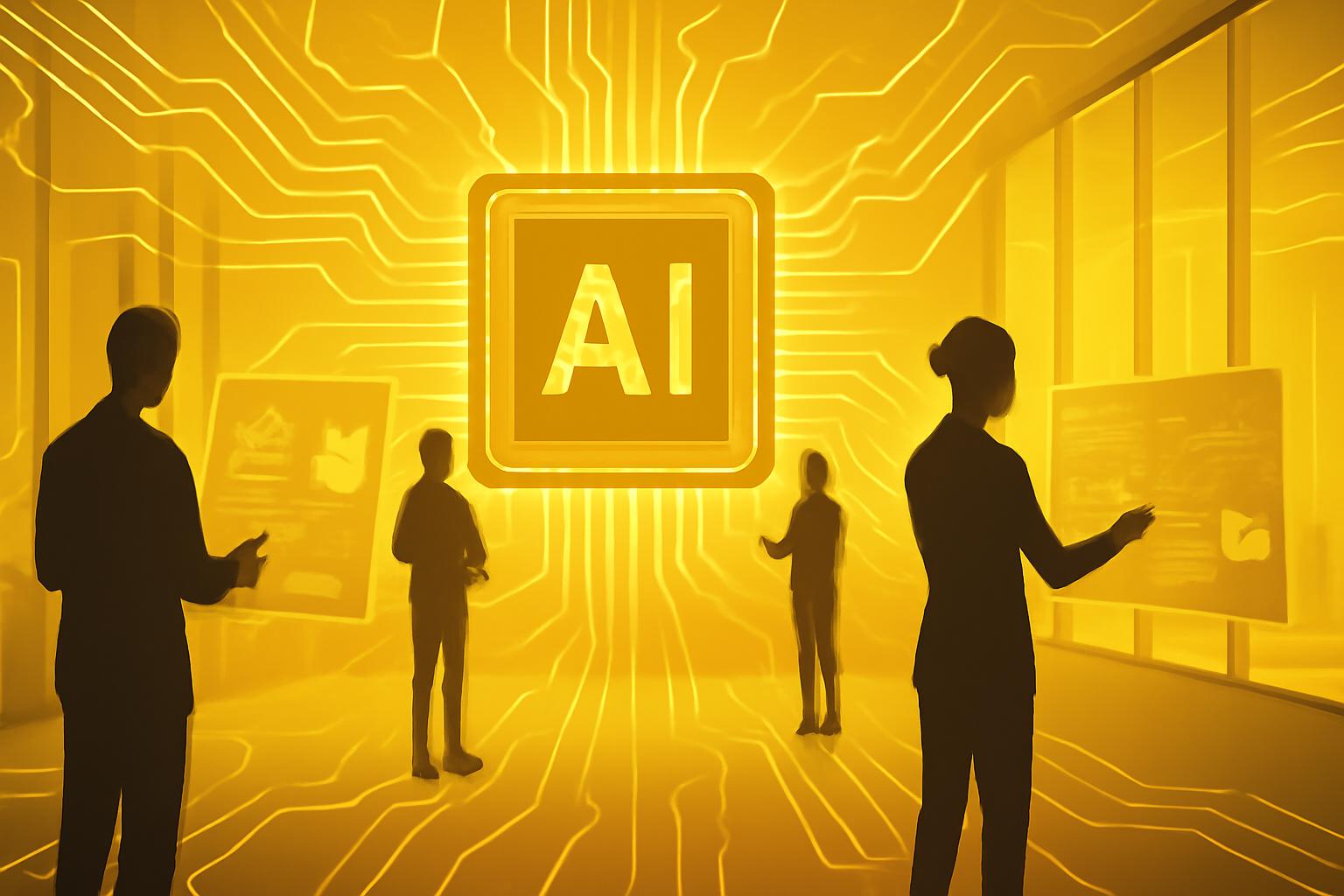OpenAI’s announced deals with AMD and Nvidia underscore the intensifying competition in AI chip manufacturing, set against a backdrop of global compute scarcity and geopolitical tensions. While these partnerships signal strategic intent, the critical factor remains the successful deployment and scaling of chip production to meet unprecedented AI demand. !-- wp:paragraph -->
- Opportunities: Accelerated AI innovation through improved chip supply; potential market leadership for chipmakers delivering superior performance; expanded AI applications across industries.
- Risks: Persistent compute shortages could limit AI growth; geopolitical risks may disrupt supply chains; emerging competitors like DeepSeek challenge U.S. dominance.
- OpenAI aims to expand AI capabilities through partnerships with leading chipmakers.
- AMD and Nvidia remain central players in supplying the high-performance hardware required for AI workloads.
- The ecosystem-wide demand for AI services is driving compute scarcity.
- Industry-wide collaboration is essential to address supply constraints.
FinOracleAI — Market View
OpenAI’s announced deals with AMD and Nvidia underscore the intensifying competition in AI chip manufacturing, set against a backdrop of global compute scarcity and geopolitical tensions. While these partnerships signal strategic intent, the critical factor remains the successful deployment and scaling of chip production to meet unprecedented AI demand. !-- wp:paragraph -->- Opportunities: Accelerated AI innovation through improved chip supply; potential market leadership for chipmakers delivering superior performance; expanded AI applications across industries.
- Risks: Persistent compute shortages could limit AI growth; geopolitical risks may disrupt supply chains; emerging competitors like DeepSeek challenge U.S. dominance.
OpenAI’s Strategy to Scale AI Model Complexity and Production
OpenAI’s collaboration with AMD is viewed as a strategic move to enhance production capabilities and support the development of more complex AI models. This effort is critical as demand for AI compute resources escalates globally. !-- wp:paragraph -->- OpenAI aims to expand AI capabilities through partnerships with leading chipmakers.
- AMD and Nvidia remain central players in supplying the high-performance hardware required for AI workloads.
- The ecosystem-wide demand for AI services is driving compute scarcity.
- Industry-wide collaboration is essential to address supply constraints.
FinOracleAI — Market View
OpenAI’s announced deals with AMD and Nvidia underscore the intensifying competition in AI chip manufacturing, set against a backdrop of global compute scarcity and geopolitical tensions. While these partnerships signal strategic intent, the critical factor remains the successful deployment and scaling of chip production to meet unprecedented AI demand. !-- wp:paragraph -->- Opportunities: Accelerated AI innovation through improved chip supply; potential market leadership for chipmakers delivering superior performance; expanded AI applications across industries.
- Risks: Persistent compute shortages could limit AI growth; geopolitical risks may disrupt supply chains; emerging competitors like DeepSeek challenge U.S. dominance.
OpenAI’s Strategy to Scale AI Model Complexity and Production
OpenAI’s collaboration with AMD is viewed as a strategic move to enhance production capabilities and support the development of more complex AI models. This effort is critical as demand for AI compute resources escalates globally. !-- wp:paragraph -->- OpenAI aims to expand AI capabilities through partnerships with leading chipmakers.
- AMD and Nvidia remain central players in supplying the high-performance hardware required for AI workloads.
- The ecosystem-wide demand for AI services is driving compute scarcity.
- Industry-wide collaboration is essential to address supply constraints.
FinOracleAI — Market View
OpenAI’s announced deals with AMD and Nvidia underscore the intensifying competition in AI chip manufacturing, set against a backdrop of global compute scarcity and geopolitical tensions. While these partnerships signal strategic intent, the critical factor remains the successful deployment and scaling of chip production to meet unprecedented AI demand. !-- wp:paragraph -->- Opportunities: Accelerated AI innovation through improved chip supply; potential market leadership for chipmakers delivering superior performance; expanded AI applications across industries.
- Risks: Persistent compute shortages could limit AI growth; geopolitical risks may disrupt supply chains; emerging competitors like DeepSeek challenge U.S. dominance.
OpenAI’s Strategy to Scale AI Model Complexity and Production
OpenAI’s collaboration with AMD is viewed as a strategic move to enhance production capabilities and support the development of more complex AI models. This effort is critical as demand for AI compute resources escalates globally. !-- wp:paragraph -->- OpenAI aims to expand AI capabilities through partnerships with leading chipmakers.
- AMD and Nvidia remain central players in supplying the high-performance hardware required for AI workloads.
- The ecosystem-wide demand for AI services is driving compute scarcity.
- Industry-wide collaboration is essential to address supply constraints.
FinOracleAI — Market View
OpenAI’s announced deals with AMD and Nvidia underscore the intensifying competition in AI chip manufacturing, set against a backdrop of global compute scarcity and geopolitical tensions. While these partnerships signal strategic intent, the critical factor remains the successful deployment and scaling of chip production to meet unprecedented AI demand. !-- wp:paragraph -->- Opportunities: Accelerated AI innovation through improved chip supply; potential market leadership for chipmakers delivering superior performance; expanded AI applications across industries.
- Risks: Persistent compute shortages could limit AI growth; geopolitical risks may disrupt supply chains; emerging competitors like DeepSeek challenge U.S. dominance.
“What we’re really seeing is a world where there’s going to be absolute compute scarcity,” OpenAI’s President remarked, highlighting the critical need for industry collaboration to meet AI compute demands.
OpenAI President, CNBC’s Squawk on the StreetAI Chip Race Intensifies Amid US-China Geopolitical Tensions
The partnerships between OpenAI, AMD, and Nvidia also reflect the broader geopolitical context surrounding AI technology. The United States and China are locked in a strategic competition, with AI playing a central role. !-- wp:paragraph --> Last year, the Chinese AI company DeepSeek claimed to have developed a lower-cost AI model, challenging U.S. dominance. DeepSeek continues to innovate, producing new open-source AI models powered by domestically manufactured chips. !-- wp:paragraph --> However, concerns about national security have risen. A recent U.S. government report highlighted that DeepSeek’s models incorporate perspectives aligned with the Chinese Communist Party more frequently than U.S. counterparts, raising flags about information integrity. !-- wp:paragraph -->OpenAI’s Strategy to Scale AI Model Complexity and Production
OpenAI’s collaboration with AMD is viewed as a strategic move to enhance production capabilities and support the development of more complex AI models. This effort is critical as demand for AI compute resources escalates globally. !-- wp:paragraph -->- OpenAI aims to expand AI capabilities through partnerships with leading chipmakers.
- AMD and Nvidia remain central players in supplying the high-performance hardware required for AI workloads.
- The ecosystem-wide demand for AI services is driving compute scarcity.
- Industry-wide collaboration is essential to address supply constraints.
FinOracleAI — Market View
OpenAI’s announced deals with AMD and Nvidia underscore the intensifying competition in AI chip manufacturing, set against a backdrop of global compute scarcity and geopolitical tensions. While these partnerships signal strategic intent, the critical factor remains the successful deployment and scaling of chip production to meet unprecedented AI demand. !-- wp:paragraph -->- Opportunities: Accelerated AI innovation through improved chip supply; potential market leadership for chipmakers delivering superior performance; expanded AI applications across industries.
- Risks: Persistent compute shortages could limit AI growth; geopolitical risks may disrupt supply chains; emerging competitors like DeepSeek challenge U.S. dominance.
“Now we will see what gets delivered. Ultimately, the best chips will win,” Gerstner stated, underscoring the competitive nature of AI hardware development.Persistent Compute Constraints Amid Expanding AI Demand
The AI industry faces ongoing challenges related to compute capacity. Despite aggressive efforts to scale up production of AI chips, Gerstner cautioned that the world remains “compute-constrained.” This scarcity is driven by the surging demand for AI services, not only from OpenAI but across the entire ecosystem. !-- wp:paragraph -->“What we’re really seeing is a world where there’s going to be absolute compute scarcity,” OpenAI’s President remarked, highlighting the critical need for industry collaboration to meet AI compute demands.
OpenAI President, CNBC’s Squawk on the StreetAI Chip Race Intensifies Amid US-China Geopolitical Tensions
The partnerships between OpenAI, AMD, and Nvidia also reflect the broader geopolitical context surrounding AI technology. The United States and China are locked in a strategic competition, with AI playing a central role. !-- wp:paragraph --> Last year, the Chinese AI company DeepSeek claimed to have developed a lower-cost AI model, challenging U.S. dominance. DeepSeek continues to innovate, producing new open-source AI models powered by domestically manufactured chips. !-- wp:paragraph --> However, concerns about national security have risen. A recent U.S. government report highlighted that DeepSeek’s models incorporate perspectives aligned with the Chinese Communist Party more frequently than U.S. counterparts, raising flags about information integrity. !-- wp:paragraph -->OpenAI’s Strategy to Scale AI Model Complexity and Production
OpenAI’s collaboration with AMD is viewed as a strategic move to enhance production capabilities and support the development of more complex AI models. This effort is critical as demand for AI compute resources escalates globally. !-- wp:paragraph -->- OpenAI aims to expand AI capabilities through partnerships with leading chipmakers.
- AMD and Nvidia remain central players in supplying the high-performance hardware required for AI workloads.
- The ecosystem-wide demand for AI services is driving compute scarcity.
- Industry-wide collaboration is essential to address supply constraints.
FinOracleAI — Market View
OpenAI’s announced deals with AMD and Nvidia underscore the intensifying competition in AI chip manufacturing, set against a backdrop of global compute scarcity and geopolitical tensions. While these partnerships signal strategic intent, the critical factor remains the successful deployment and scaling of chip production to meet unprecedented AI demand. !-- wp:paragraph -->- Opportunities: Accelerated AI innovation through improved chip supply; potential market leadership for chipmakers delivering superior performance; expanded AI applications across industries.
- Risks: Persistent compute shortages could limit AI growth; geopolitical risks may disrupt supply chains; emerging competitors like DeepSeek challenge U.S. dominance.
Gerstner Highlights OpenAI’s Announced Deals with AMD and Nvidia
Brad Gerstner, founder and CEO of Altimeter Capital, addressed the recent announcements of OpenAI’s partnerships with AMD and Nvidia at the Delivering Alpha conference in New York City. While the deals mark significant milestones, Gerstner emphasized to CNBC that these are announcements rather than immediate chip deployments. !-- wp:paragraph -->“Now we will see what gets delivered. Ultimately, the best chips will win,” Gerstner stated, underscoring the competitive nature of AI hardware development.Persistent Compute Constraints Amid Expanding AI Demand
The AI industry faces ongoing challenges related to compute capacity. Despite aggressive efforts to scale up production of AI chips, Gerstner cautioned that the world remains “compute-constrained.” This scarcity is driven by the surging demand for AI services, not only from OpenAI but across the entire ecosystem. !-- wp:paragraph -->“What we’re really seeing is a world where there’s going to be absolute compute scarcity,” OpenAI’s President remarked, highlighting the critical need for industry collaboration to meet AI compute demands.
OpenAI President, CNBC’s Squawk on the StreetAI Chip Race Intensifies Amid US-China Geopolitical Tensions
The partnerships between OpenAI, AMD, and Nvidia also reflect the broader geopolitical context surrounding AI technology. The United States and China are locked in a strategic competition, with AI playing a central role. !-- wp:paragraph --> Last year, the Chinese AI company DeepSeek claimed to have developed a lower-cost AI model, challenging U.S. dominance. DeepSeek continues to innovate, producing new open-source AI models powered by domestically manufactured chips. !-- wp:paragraph --> However, concerns about national security have risen. A recent U.S. government report highlighted that DeepSeek’s models incorporate perspectives aligned with the Chinese Communist Party more frequently than U.S. counterparts, raising flags about information integrity. !-- wp:paragraph -->OpenAI’s Strategy to Scale AI Model Complexity and Production
OpenAI’s collaboration with AMD is viewed as a strategic move to enhance production capabilities and support the development of more complex AI models. This effort is critical as demand for AI compute resources escalates globally. !-- wp:paragraph -->- OpenAI aims to expand AI capabilities through partnerships with leading chipmakers.
- AMD and Nvidia remain central players in supplying the high-performance hardware required for AI workloads.
- The ecosystem-wide demand for AI services is driving compute scarcity.
- Industry-wide collaboration is essential to address supply constraints.
FinOracleAI — Market View
OpenAI’s announced deals with AMD and Nvidia underscore the intensifying competition in AI chip manufacturing, set against a backdrop of global compute scarcity and geopolitical tensions. While these partnerships signal strategic intent, the critical factor remains the successful deployment and scaling of chip production to meet unprecedented AI demand. !-- wp:paragraph -->- Opportunities: Accelerated AI innovation through improved chip supply; potential market leadership for chipmakers delivering superior performance; expanded AI applications across industries.
- Risks: Persistent compute shortages could limit AI growth; geopolitical risks may disrupt supply chains; emerging competitors like DeepSeek challenge U.S. dominance.













